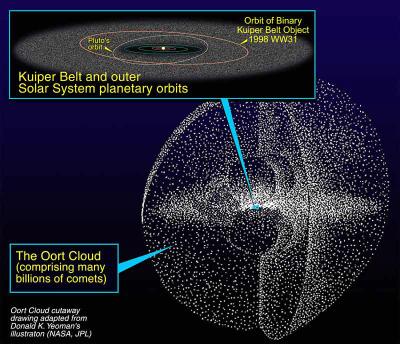
 |
The Oort Cloud |
|
| |
|
Comets with orbital periods (the time taken for them to orbit the sun) less than 200 years are believed to come from the Kuiper Belt beyond Pluto. Longer period orbits are said to originate in the Oort Cloud. 
[click to enlarge] In 1950, Dutch astronomer Jan Hendrik Oort [1900-92] made a study of comets with the largest orbits. The following was already known about them:
Oort discovered that not only were the orbits concentrated towards the very large, they actually peaked out, most falling in from around 50,000 AU. |
PerturbationsFurthermore Oort noticed that most of the comets' orbits must have been new - in other words, the first time they had visited the inner solar system. The planets (massive Jupiter in particular) exert a gravitational pull on comets, perturbing their orbits. This could not have happened for the orbits observed, revealing the comets as new visitors. Piecing all the mathematical evidence together, Oort concluded that the solar system is surrounded by a vast sphere of icy rocks (comet nuclei) at a distance of 50,000 AU - over 1200× the distance of Pluto from the Sun - that occasionally fall in to visit us. New CometsWhat causes the comets to come careering in to the very heart of the solar system becomes clearer when you consider the scale. The nearest star is just over 4 light years [ly] away from the Sun. The furthest edge of the Oort cloud is believed to be 0·8 ly away. This means that the gravity of nearby stars in the Galaxy may disturb their very slow orbits. Related topic: Kuiper Belt |
|
Sun | Mercury | Venus | Earth | Moon | Mars | Asteroids | Jupiter | Saturn | Uranus | Neptune | Pluto | X | Kuiper | |